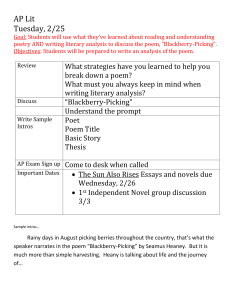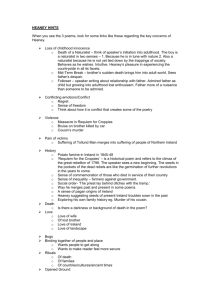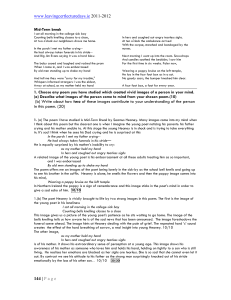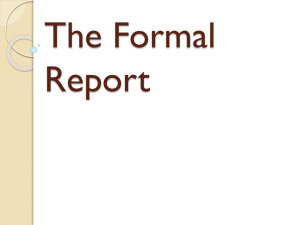Seamus Heaney
advertisement
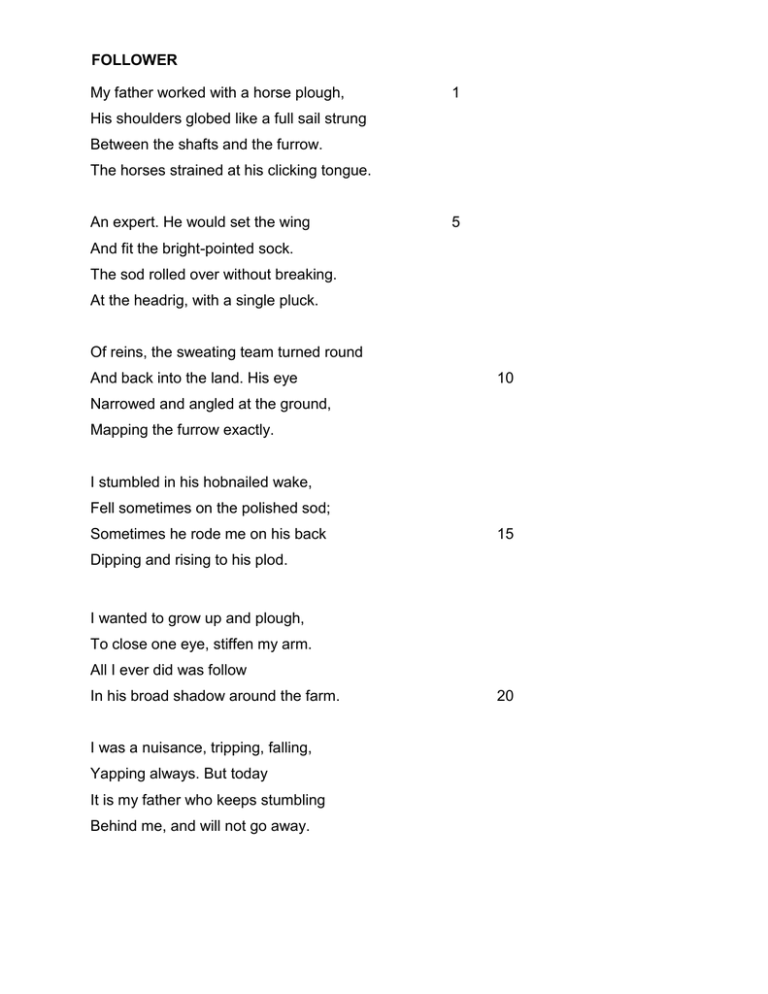
FOLLOWER My father worked with a horse plough, 1 His shoulders globed like a full sail strung Between the shafts and the furrow. The horses strained at his clicking tongue. An expert. He would set the wing 5 And fit the bright-pointed sock. The sod rolled over without breaking. At the headrig, with a single pluck. Of reins, the sweating team turned round And back into the land. His eye 10 Narrowed and angled at the ground, Mapping the furrow exactly. I stumbled in his hobnailed wake, Fell sometimes on the polished sod; Sometimes he rode me on his back 15 Dipping and rising to his plod. I wanted to grow up and plough, To close one eye, stiffen my arm. All I ever did was follow In his broad shadow around the farm. I was a nuisance, tripping, falling, Yapping always. But today It is my father who keeps stumbling Behind me, and will not go away. 20 Analysis This poem examines Heaney’s relationship with his father and the effects of ageing. The skilled nature of his father (also examined in Digging) is shown in the opening stanza where his power as a farmer is described. The simile ‘his shoulders like a full sail strung between the shafts and the furrow’ emphasizes how powerful and vast he appeared to Heaney as a child. He also controlled the horses merely by clicking his tongue, showing how skilled he is. The second stanza puts it very simply: ‘an expert’ in the first two words, a sentence on its own to emphasize how important this is. His qualities are further emphasized when he tells us ‘the sod rolled over without breaking’ to show his expertise. In the third stanza Heaney describes how he gets the horses as a ‘team’ to move effortlessly and turn round whilst he uses his skills to map ‘the furrow exactly’. Heaney, by comparison is clumsy and ‘fell sometimes on the polished sod’. He lacks the control and power of his father who carries him ‘on his back’ effortlessly. The fifth stanza shows how much he admired his father as ‘I wanted to grow up and plough’ and to do the things his father so skillfully did. However he seems sad that all he did was get in his father’s way and followed him around. His father has a ‘broad shadow’ to show his size compared to Heaney and the fact that Heaney lived his life in his father’s shadow. The final stanza emphasizes how Heaney saw himself as a ‘nuisance, tripping, falling, yapping always’ but this is followed by a change as we move back to the present to discover it is Heaney’s father who is a nuisance to him, ‘stumbling behind me’, a reminder that we all grow old, sadly. The final words ‘and will not go away’ seem harsh, as if Heaney finds his father an irritant, yet his father put up with him when he was a young boy, getting in the way. It almost seems selfish, but possibly shows how people do find caring for their elderly relatives a difficult thing to do. Follower The title of this poem is ambiguous - it shows how the young Heaney followed his father literally and metaphorically. The child sees farming as simply imitating his father's actions (“close one eye, stiffen my arm”), but later learns how skilled the work is. He recalls his admiration of his father then; but now his father walks behind (this metaphor runs through the poem). Effectively their positions are reversed. His father is not literally behind him, but the poet is troubled by his memory: perhaps he feels guilt at not carrying on the tradition of farming, or feels he cannot live up to his father's example. The poem has several developed metaphors, such as the child's following in his father's footsteps and wanting to be like him. The father is sturdy while the child falls - his feet are not big enough for him to be steady on the uneven land. There are many nautical references: The father's shoulders are like the billowing sail of a ship. The “sod” rolls over “without breaking” (like a wave). The child stumbles “in his wake” and dips and rises on his father's back. “Mapping the furrow” is like navigating a ship. In these images the farmer is not shown as simple but highly skilled. Heaney uses specialized terms (a special lexicon or register) from ploughing - terms such as “wing”, “sock” and “headrig”. There are many active verbs - “rolled”, “stumbled”, “tripping”, “falling” and “yapping”. There are lots of monosyllables and colloquial vocabulary, frequently as the rhyme word at the end of line. Some of these terms sound like their meaning (onomatopoeia), like “clicking”, “pluck” and “yapping”. The metre of the poems is more or less iambic (in tetrameters - four poetic feet/eight syllables to each line) and rhymed in quatrains (stanzas of four lines). We see a phrase without a verb written as sentence: “An expert”. The poet uses contrast - apart from the general contrast of past and present we note how: the father's control is effortless (“clicking tongue” or “single pluck/Of reins”) while the powerful horses (“sweating team”) strain, and how the young Seamus “wanted to grow up and plough.” but all he “ever did was follow”. In thinking about the poem you might like to consider these questions: What does the poem show of the relationship of father and son, and how time has changed this? What does the last line of the poem mean? Does Heaney really want his father to “go away”? Is this a poem about farming specifically or is it relevant to other skills and occupations? How does Heaney explore the idea of family tradition here? Mid-Term Break by Seamus Heaney I sat all morning in the college sick bay Counting bells knelling classes to a close. At two o'clock our neighbors drove me home. In the porch I met my father crying-He had always taken funerals in his stride-And Big Jim Evans saying it was a hard blow. The baby cooed and laughed and rocked the pram When I came in, and I was embarrassed By old men standing up to shake my hand And tell me they were "sorry for my trouble," Whispers informed strangers I was the eldest, Away at school, as my mother held my hand In hers and coughed out angry tearless sighs. At ten o'clock the ambulance arrived With the corpse, stanched and bandaged by the nurses. Next morning I went up into the room. Snowdrops And candles soothed the bedside; I saw him For the first time in six weeks. Paler now, Wearing a poppy bruise on his left temple, He lay in the four foot box as in his cot. No gaudy scars, the bumper knocked him clear. A four foot box, a foot for every year. MID-TERM BREAK The subject of this poem is the death of Seamus Heaney’s younger bro ther, Christopher who was killed by a car at the age of four. It is a tremendously poignant poem and its emotional power derives in large measure form the fact that Heaney is very muted and understated with respect to his own emotional response. He chooses to focus more upon the reaction of his parents in order to convey the shocking impact of the death of their little boy. Usually, we must careful not to assume the “I” in a poem is, in fact, the poet. In this case, though, we may be sure that Mid-Term Break is purely and intensely autobiographical. This beautiful lyric poem is certainly enormously moving. It presents an elder brother having to deal with a terrible trauma. As is frequently the case with Heaney, there is an arresting amalgam of manliness and tenderness in the writing that lends it both warmth and astringency at the same time. This poem is powerfully moving because of its emotional restraint and control of tone. Heaney concentrates on observed details and it is the accumulation of these details that helps to make the poem so memorable. An elegiac tone is established at the beginning of the poem. An elegy is a poem written to commemorate a dead person who is traditionally resurrected in a benign landscape. Here, though, the little boy is recalled with clarity and realism; Heaney finishes with the rueful and terrible equation “A four foot box, a foot for every year”, which starkly conveys the shocking loss of a young child. The poem opens with a line that might easily describe any child but the sec ond line introduces a darkly foreboding atmosphere: “I sat all morning in the college sick bay Counting bells knelling classes to a close.” The word “knell” is appropriate in the context of a poem about death because it is the sound of a funeral bell. We do not normally associate school bells with death but this day was to prove horrifically different for the poet. The rhythm and alliteration also reinforce the mour nful tone. The ‘c’ an ‘l’ sounds, as well as the internal rhyme of “bells” and “knelling” help to suggest both the idea of finality and of time seeming to slow down. The poet is driven home by his neighbours and not his parents, another unusual event preparing the reader for the idea that something is terribly wrong. The fact that Heaney remembers the precise time, “two o’clock” is convincing as we all tend to remember precise timings when recalling traumatic, like changing events. Stanza two concentrates on the poet’s father’s emotional response who is “crying”. Heaney tells us that his father “had always taken funerals in his stride” but this death is unnatural as well as personal. The be bereft of a little child is unbearable for the normally rock solid father who would, we assume, be the sort of man to offer words of comfort to others just as “ Big Jim Evans” offers his to Heaney’s family in “saying it was a hard blow.” (line 6) There is a terrible double meaning in the phrase “hard blow” because Jim Evans, by referring to the emotional impact of Christopher’s death, also unwittingly uses language that recalls the impact of the car that killed him. The third stanza presents us with another contrast, the baby’s innocent joy at seeing his elder brother. Remembering the title of the poem, we might be tempted to hope, along with the Heaney family that this event is some terrible nightmare that might be woken up from. The baby’s normal behaviour, though, only accentuates the reality of the situation. From a technical point of view, Heaney’s skillful use of the iambic pentameter helps to emphasize the family drama that is played out in the poem. The baby’s innocent obliviousness to the tragic circumstance of his elder brother’s return from school is captured in, “The baby cooed and laughed and rocked the pram.” The bouncy emphatic rhythm is in direct contrast to the opening stanza’s measured pace. The unusual aspect of the situation is developed further in lines 8-11 as the young Heaney is “embarrassed” by the proffering of sympathy from “old men”. Their awkwardness is economically conveyed through their euphemistic use of language in telling him that “there were sorry” for his “trouble” (line10). The sibilant alliteration in “Whispers informed strangers I was the eldest” (line 11) captures the hushed, muted atmosphere in the house. Heaney goes on to concentrate upon his mother’s reaction to her little boys’ death who says nothing but holds his hand in her own as she “coughed out angry tearless sighs” (line 13). The implication here is that she has cried so much that there is nothing more to cry but incense d by the driver’s failure to avoid her son. Line 14 begins with another precise time reference and the reality of the family having to receive “the corpse”. This is the first time that we know that the “trouble” is connected with. The sixth stanza recounts the poet’s visit to his brother’s room. Heaney conveys the feeling of being unable to name the reality of the situation: “Next morning I went up into the room.” (LINE 16) He does not go on to say that this is where his little brother is lying dead. Instea d the surrounding details emphasise the atmosphere of quiet as the boys are reunited after “six weeks”. The snowdrops and candles are symbolic of life but they are also ritualistically funereal. The word “soothed” may be applicable to both the idea that th e flowers and candles are placed as a comfort to the dead boy but they are also for the solace of the grieving family. Unable to articulate the reality of his brother’s death, the poet chooses to present his earlier self, noticing that he was “Paler” (line 18). Another flower image draws attention to the apparently insignificant injury that had such a devastating effect, as well as the fragility of life with which the poppy is traditionally associated: “Wearing a poppy bruise on his left temple, He lay in the four foot box as in his cot. No gaudy scars, the bumper knocked him clear. A four foot box, a foot for every year.” The description here becomes almost unbearably powerful because of the restraint Heaney exercises. The young boy could easily be asleep but, tragically, it is only as if he were asleep. He will never wake up again. The word “cot”, along with the earlier use of “pram” in stanza three emphasizes the unnatural eruption of death into the life of a family with very young children. It also helps to highlight the horror faced by any parent who is predeceased by a child. The final couplet is consistent in tone with the remainder of the poem. Heaney chooses to add a single line stanza to complete the poem that has seven three line stanzas preceding i t. The effect of this is to present a terrible equation on its own, something that stands out baldly and inescapably. Just as there are “No gaudy scars” visible on the poor child’s body, so too there is no lurid concentration upon injury or any self-indulgent displays of grief. The final line is, in a sense, “knocked clear” of the rest of the poem through Heaney’s decision to separate it. There is a heartbreaking logic in the statement that reminds us both of the small stature of the child and the brevity of his young life. As a lyric poem commemorating a terrible event, it is difficult to imagine anything to surpass it for control, truthfulness and austere reverential beauty. Mid-Term Break The poem is about the death of Heaney's infant brother (Christopher) and how people (including himself) reacted to this. The poem's title suggests a holiday but this “break” does not happen for pleasant reasons. For most of the poem Heaney writes of people's unnatural reactions, but at the end he is able to grieve honestly. The boredom of waiting appears in the counting of bells but “knelling” suggests a funeral bell, rather than a bell for lessons. The modern reader may be struck by the neighbours' driving the young Seamus home - his parents may not have a car (quite usual then - Heaney was born in 1939, and is here at boarding school, so this is the 1950s) or, more likely, were too busy at home, and relied on their neighbours to help. The father, apparently always strong at other funerals, is distraught (very upset) by his child's death, while the mother is too angry to cry. “Big Jim” (apparently a family friend) makes an unfortunate pun he means to speak of a metaphorical “blow”, of course. The young Seamus is made uneasy by the baby's happiness on seeing him, by hand shaking and euphemisms (evasions, like “Sorry for my trouble”), and by whispers about him. When late at night the child's body is returned Heaney sees this as “the corpse” (not a person). This contrasts wonderfully with the final section of the poem, where he is alone with his brother. Note the personal pronouns “him”, “his”, “he” - as opposed to “the corpse”. The calm mood is beautifully shown in the transferred epithet (“Snowdrops/And candles soothed the bedside” - literally they soothed the young Heaney). The flowers are a symbol in the poem, but also in reality for the family (a symbol of new life, after death). The bruise is seen as not really part of the boy - he is “wearing” it (a metaphor), as if it could come off. Heaney likens the bruise to the poppy, a flower linked with death and soothing of pain (opiates come from poppies). The child appears as if sleeping (a simile). We contrast the ugly “corpse, stanched and bandaged”, which becomes a sleeping child with “no gaudy scars” - dead, but, ironically, not disfigured. The last line of the poem is most poignant and skillful - the size of the coffin is the measure of the child's life. We barely notice that Heaney has twice referred to a “box”, almost a jokey name for a coffin. Overall, we note the contrast between the embarrassing scenes earlier and the final section where, alone with his brother, Heaney can be natural. The poem has a clear formal structure, in three line stanzas with a loose iambic metre. There are occasional rhymes but the poem's last two lines form a rhyming couplet, and emphasize the brevity of the child's life. Many of the lines run on - they are end stopped only in the last line of a stanza, and in three cases the lines run on from one stanza to the next. As in much of Heaney's poetry, there is no special vocabulary - mostly this is the common register of spoken English. Contrast the reactions of the two parents - how does the reader react to this? With whom, do you think, is the mother angry? How does the poem contrast the fuss of the homecoming with the calmness of the scene when Seamus sees his brother's body? What do you think is the meaning of the poem's last line? Please note: lA foot is an iamb if it consists of one unstressed syllable followed by a stressed syllable, so the word remark is an iamb. Pent means five, so a line of iambic pentameter consists of five iambs – five sets of unstressed syllables followed by stressed syllables.

